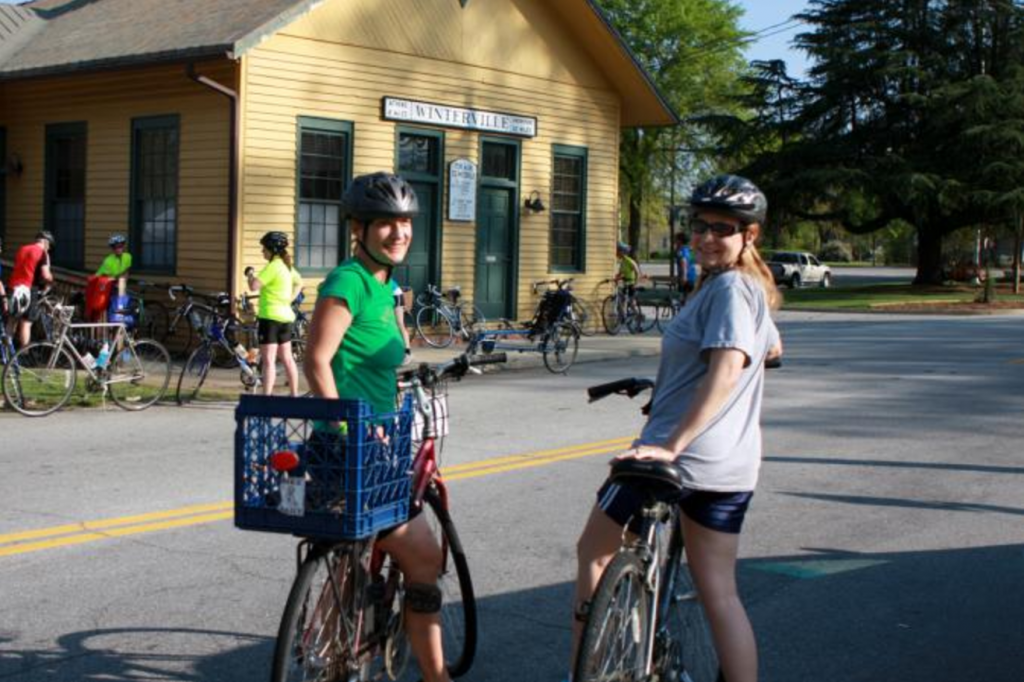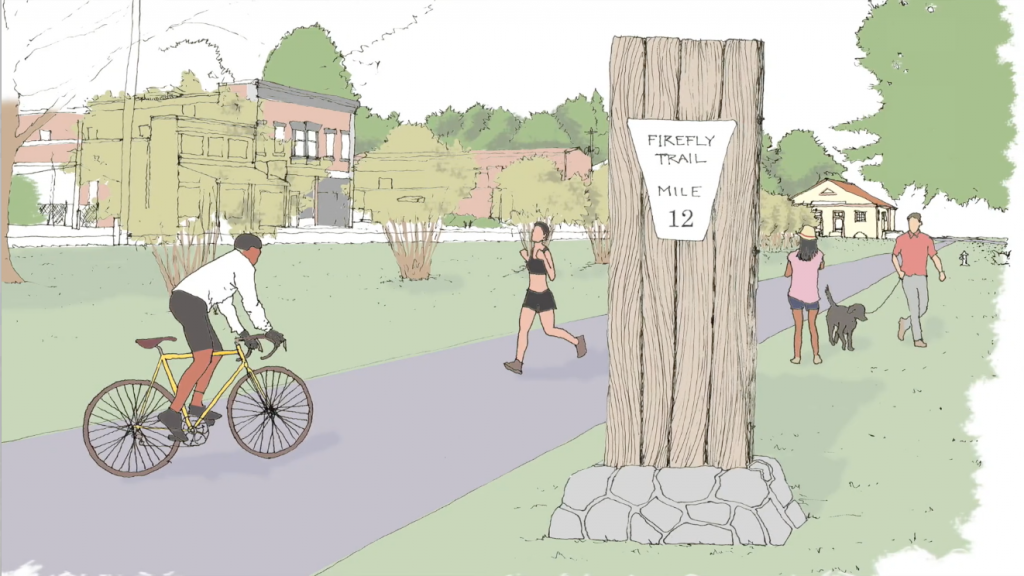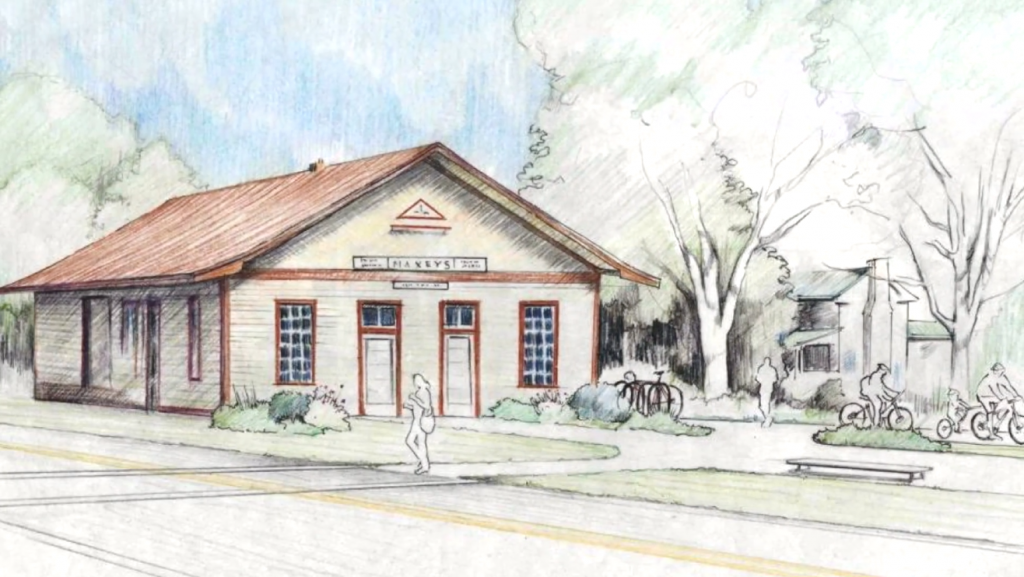How they did it: Georgia’s Firefly Trail unlocks public funding through a grassroots campaign
Published February 21, 2018
The Firefly Trail was one of ioby’s largest-budget projects to date. Learn how its leaders leveraged their ioby campaign to bring even more good change to their community.
In the spring of 2017, ioby Leader Ivette Lopez Bledsoe led her fellow Firefly Trail board members in raising over $62,000 on ioby for the trail’s Model Miles Project. An effort to build a 39-mile multimodal rail trail from Athens to Union Point, Georgia, had been afoot for at least the past 10 years, but progress was slow. The Board realized that raising funds for “Model Miles” in the communities of Athens, Maxeys, and Union Point would help move the project forward. Then, the board saw a rare opportunity that promised to transform the trail-creation process.

The Firefly Trail board knew that on November 7, 2017, Athens-Clarke County voters would decide whether to approve TSPLOST, the Transportation Special Purpose Local Option Sales Tax. This one percent sales tax would provide funding for investments in and repairs to local transportation facilities and infrastructure projects. The board had gained widespread public support for their project, but they had to get the trail included as a project on the ballot first.
“That’s one of the beautiful things about crowdfunding,” Ivette says. “It allows you to strategically plan, and it helps propel you into that category of being available for larger funding. We believe that our ioby crowdfunding campaign really helped elevate awareness for the need to have the Firefly Trail, thus influencing that it be part of the TSPLOST initiative.”

In November, Athens-Clarke County voted to fund approximately seven miles of the Firefly Trail through TSPLOST. An impressive $16 million is now slated for construction of this long-awaited transportation and recreation corridor in the footprint of the historic Athens Branch of the Georgia Railroad.

How did they do it? We asked Ivette.
Q: How did you get involved with the Firefly Trail’s ioby campaign? What was your role?
A: I describe it as being like the old “See if Mikey likes it” cereal commercial. I approached the board, and they offered me a position, but they wanted me to take charge of the crowdfunding campaign. I was naive, so I said sure! Like Mikey, I didn’t know any better, so I took it on. But, as in the commercial, it turned out well.
I started looking into how to crowdfund, and that’s when I discovered ioby. I spoke with [ioby Leader] Aylene McCallum, and she told me how great and helpful ioby was—I love that you all have that kind of community. At that time, our board’s focus was really on: “We have to bring attention to this. If we can raise this money and get these three model miles built, we’re back in the game. If not, we may be out.” No one ever said that, but after a lot of prior roadblocks, that was the feeling. So I jumped in with ioby’s help, and our very committed board.
The community that formed around this board… They persevered year after year through many disappointments. I remember thinking, “They really believe in this thing. I want to be around people like this who never give up. They have staying power.” I was so fortunate to work with so many great people.
My role was that of a placeholder in a lot of ways: keeping people on track—based on what I learned from ioby! It was that perfect mix of a very fired-up, committed board with excellent counsel from you all. I’m glad I was able to serve as that intermediary person, going back and forth between both, but it really was just excellent, phenomenal teamwork. My experience with it was invaluable; I couldn’t put a price on it. There was no face on this project; everyone did their part. That’s what made the difference.
Q: How did your ioby campaign relate to the $16 million in funding you gained through the TSPLOST initiative?
A: From the start, we had planned to dedicate a small percentage of our ioby campaign funds to promoting the trail in Athens-Clarke County. Once we knew TSPLOST was coming on the ballot, our strategy became apparent: as much as we were raising money, we were raising awareness, and the political will to keep the project going. We knew that funding these initial “model miles” would help demonstrate the benefits the full trail would provide. As the money kept coming in, it brought more and more attention to how much the community wanted this trail.
I can say that, after working hard on the campaign for several months, everyone on that board was tired of asking for money. But we huddled up, we went out there, we asked one more time, and we got it. Everyone worked hard, but there was a small group in particular who hit it hard every single day, and they were so well-connected that there was a great ripple effect.
Then it was a landslide vote in November. It was almost a mandate—like 65/35.
Q: How did your success with crowdfunding help propel you onto the ballot?
A: When people open up their wallets and give, that speaks really loudly. It shows great enthusiasm. Crowdfunding puts you on a stage for a time: people watch. And I think when people give, they become like your project’s private ambassadors—or like stockholders! They have bought into something that they want to see succeed. They want it to give something back—not money, but something for the public good. So, when we went before the project selection committee and the Mayor and Commission, our donors gave us tremendous credibility.
When I was looking into crowdfunding for trails and bike lanes, I found there was a lot of criticism. People would say, “You should never use crowdfunding to try to raise money for things that should be paid for by taxes—it’s wrong!” But I thought about that and decided: no. Crowdfunding is not a long-term fix, but it is a way of saying, “This matters to me.”
Like a kid who says to Mom and Dad, “I really want a car,” and the parents say no. If the kid then goes and raises $3,000 for it, that shows they really care about it, that they’ll probably take good care of it, et cetera. It shows awareness, commitment, ownership. The people who donated to the Firefly Trail are always going to know they invested in it—and that they did so beyond what was required of them, as is the case with a tax. So there’s that shareholder analogy again. These projects do more than raise money: they raise so much awareness, and they speak volumes about people’s commitment to a project.
Q: What’s next for the Firefly Trail?
A: The funding for the first part of our three-part strategy—the northern section—is now pretty secure. Now we need to build up the southern part: from Maxeys to Union Point. Our ioby campaign was so successful, it kept bringing more and more donations way after the deadline. This additional money has allowed us to apply for other grants and provide “match” funds to build about a mile of trail in each town. It was truly a domino effect!
We’re also putting together local action communities in the southern section to build the same momentum and community embracement, so they can own it just like Athens-Clarke County owned it. It’s really not our trail; it’s the community’s trail. We’re hoping to bring that awareness to the southern end.
There might be another crowdfunding campaign in the future; I can’t say. But there is a tremendous amount of activity going on in that southern half, and we’re working to make some great strides there.
